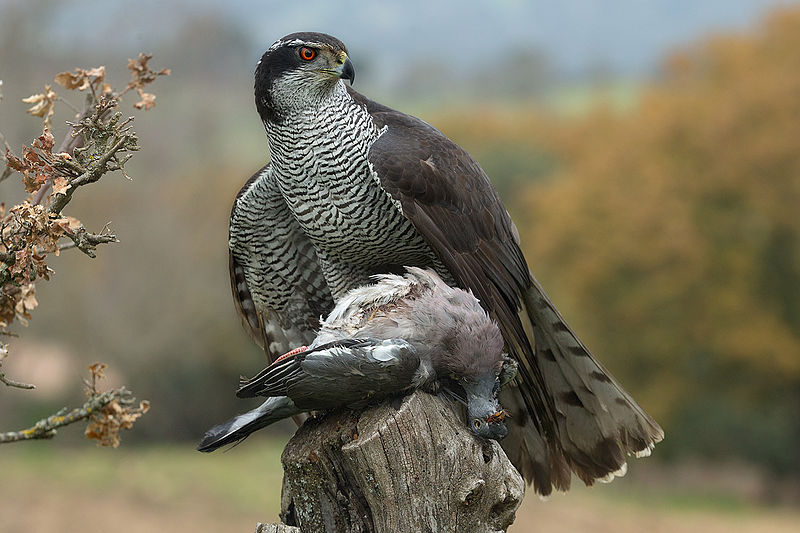Summary of Rare Bird of Prey Goshawk Species Bounce Back Thriving From Supposed Extinction:
The rare goshawk, a bird of prey, has successfully recovered after nearly going extinct for 120 years. Forestry England had recorded 45 pairs of goshawks since 2002 when the first pair returned to the New Forest. Goshawks are elusive and known as the “phantoms of the forest.” The population will spread throughout Hampshire and Dorset in the coming years. Observations and nest camera footage have provided valuable insights into the behavior and diet of goshawks. The recovery of goshawks is seen as a success for conservation and indicates the health of the forest and its supporting species.
1. Goshawks, a rare species of bird of prey, have successfully recovered after 120 years on the brink of extinction.
2. The elusive nature of goshawks earned them the nickname “phantoms of the forest.”
3. Observations and monitoring by Forestry England have revealed the flourishing population of goshawks in the New Forest.
4. Nest cameras have provided valuable insights into goshawk behavior, including parental care and prey consumption.
5. The recovery of goshawks signifies a conservation success and highlights the importance of apex predators in maintaining ecosystem balance.
Goshawks, a scarce species of bird of prey, have remarkably recovered after teetering on the edge of extinction for 120 years. These majestic creatures, often called the “phantoms of the forest,” have managed to bounce back and thrive, much to the delight of nature enthusiasts and conservationists alike.
Since the first pair of goshawks returned to the woodland in 2002, Forestry England has recorded 45 pairs of these elusive birds. It is fascinating as these secretive hunters gracefully navigate the New Forest, discreetly preying on their victims while soaring through the air with incredible speed.
Andy Page, an expert from Forestry England, predicts that the goshawk population will gradually spread across Hampshire and neighboring Dorset, further cementing their successful recovery. Before Before2002, it was widely believed that the goshawks had vanished from the New Forest for more than a centuoveroshawk is a large hawk, similar in size to a predator, with its distinguishing feature being a white stripe above its vibrant red eyes. Adult goshawks have a broad wingspan ranging from approximately 135 to 165 cm, whereas juveniles have a brown cap. This notable sexual dimorphism is further highlighted by the weight difference, with males weighing between 600 and 1,100 grams less than their female counterparts, which can weigh between 900 and 2,000 grams.
The recovery of the goshawk population has been thoroughly monitored and observed by a dedicated team from Forestry England. They have spent countless hours documenting mating activity, closely monitoring king population growth and breeding success within the woodland.
One remarkable highlight from their observations was the successful rearing and fledging of three goshawk chicks by a nesting pair atop one of the forest’s towering trees. This incredible feat was made possible by using a nest camera, which provided valuable insights into the behavior of these birds. For example, the team witnessed a male goshawk displaying extraordinary parental care during a scorching spell. Concerned about the impact of the heat on his young, he spent significant time spreading his wings to provide shade for the chicks.
The data collected from the nest camera also shed light on the goshawks’ diet, revealing their consumption of various prey. Squirrels, tiny birds, and small animals were all seen being carried into the nest to feed the hungry chicks. This observation highlights the importance of a diverse food source for the young goshawks’ well-being. The size difference between the larger female and smaller male allows them to access various food sources, ensuring their offspring receive proper nourishment.
The team conducts measurements and weight checks on the chicks before they hatch to further understand the health and conditions required to support the goshawk population. The rings found on these birds serve as valuable indicators of their movement beyond the forest, providing crucial insights into the population’s spread.
Andy Page emphasized that the current population of 45 pairs in the New Forest is just the beginning, with expectations of a significant increase throughout Hampshire and the neighboring Dorset in the next decade. This recovery represents a true success story for conservation efforts. Goshawks, as thriving apex predators, offer valuable insights into the state of the forest and the diverse range of species it supports.
The resurgence of the goshawk population is a testament to the resilience and adaptability of nature. By closely monitoring and protecting these magnificent creatures, we can ensure their survival and maintain the delicate balance of our ecosystems. The recovery of goshawks serves as an inspiration and a reminder of the extraordinary wonders nature offers. Let us continue to cherish and protect these unique species for generations to come.
Refer to “Rare goshawk thrives in Hants, the New Forest” – ITV News
– “New Forest sees conservation success with 45 pairs of goshawks” – Advertise & Times
– “Goshawks making an incredible comeback in New Forest” – BBC


